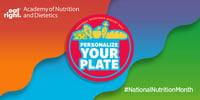National Nutrition Month is here! This is a great time to look at food choices, and evaluate whether you’re getting the most nutrition out of your meals. While the meal requirements for older adults are a bit different, making healthy meals for seniors doesn’t have to be complicated! Here are a few easy guidelines to improve the nutritional value of senior meals.
Look Out For Extra Sodium
A lot of packaged foods contain sodium as a preservative and as a way to make the food more palatable. Unfortunately, these high sodium levels are not ideal for senior meals. Be sure to read the label carefully on store-bought convenience meals, as well as many condiments, as these can be incredibly high in sodium.
Many canned foods offer low sodium (and even no sodium) options, so you can add your own salt as needed. A little table salt can go a long way! Another way to season foods without adding extra salt, is to use herbs and spices. Be sure to check the nutrition information on spice blends, and opt for the salt-free versions where possible.
Make Veggies King
Vegetables are incredibly nutrient dense - they’re low in calories and high in vitamins and minerals. Their high fiber and water content also makes vegetables more filling, ideal for the reduced-caloric content of meals for seniors.
In order to receive enough nutrition, while keeping calories low, challenge yourself this National Nutrition Month to fill half of your plate at every meal with vegetables, dividing the other half between protein and starches. Keep things exciting by eating a variety of different colors and textures. Different colored vegetables tend to offer different nutritional profiles, so varying color choices on your plate can provide a well-rounded selection of nutrients.
Avoid Empty Calories
Cookies, crackers and other baked goods may taste delicious, but they generally offer no nutritional value for all of those calories. If you’re craving a sweet treat, reach for a piece of fruit, or a yogurt with berries and granola.
For healthier, savory options, avoid packaged snacks like chips and crackers, which contain a lot of added salt and oil, but have little nutritional value. Instead of reaching for that box of buttery crackers, try whole grain pretzels instead. Whole grain pretzels contain more vitamins, minerals and fiber, with fewer calories and less fat than traditional crackers.
Try More Whole Grain Options
Another way to increase the nutritional benefits of senior meals, is to choose whole grain products over their refined counterparts. Whole grains still have the bran and germ intact, making them appear darker in color. It’s these parts of the grain that contain the most vitamins and minerals. Whole grains also contain more fiber, so they often take longer to digest than refined grains, and can be more filling.
Try and make half of your grain choices throughout the day whole grains to receive more vitamins, minerals and fiber.
Hydrate!
Be sure that you’re drinking enough water. Hydrating properly will help to flush out extra salt, as well as keep all your organs running as they should. Keeping a water bottle with you throughout the day can ensure that you’ve always got hydration close at hand.
Ease Into Exercise
Healthy eating doesn’t have to stop at food choices. Exercise is an important part of a healthy lifestyle, and can complement those nutrient-dense senior meals. Bodies are all different, and thrive with different styles and levels of exercise. The important thing is to move, and get blood flowing.
Short walks and light stretching can be a great way to increase blood flow and joint mobility, without being strenuous. It’s important to choose activities that you enjoy, and to remember that every little bit counts. You don’t need to run a marathon to receive the benefits of moving around!
Watch Portion Sizes
The most obvious difference between meals for seniors, and meals for younger adults is portion sizes. As people age, their caloric requirements decrease, so senior meals should be smaller. Many restaurants now offer smaller menu options, though eating proper portions at home can still be a challenge!
National Nutrition Month is a great time to learn more about portion sizes, and grab those measuring cups. Measuring out different foods can ensure that the meal is the appropriate size, and can prevent accidental overeating. Another solution for perfectly portioned meals is to consider a meal delivery service. Home delivered meals are perfectly portioned, nutritionally balanced, and can be tailored to meet special dietary needs.











